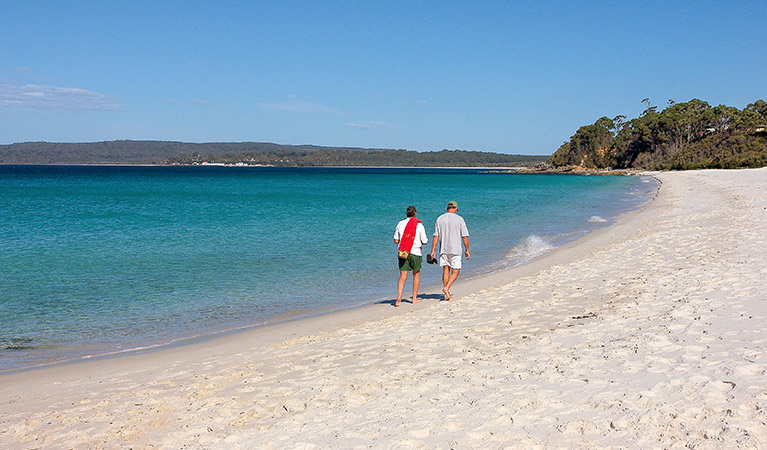Jervis Bay National Park
Overview
Explore the natural beauty of Jervis Bay National Park on NSW's sparkling South Coast, near Nowra. Discover Aboriginal heritage, visit Hyams Beach, renowned for its white sand, whale watching and water activities.
Read more about Jervis Bay National Park
With its powder-white sands, crystal clear waters, forests, woodlands and wetlands, Jervis Bay National Park is an ideal getaway. Its rich Aboriginal heritage goes back thousands of years and local Aboriginal people maintain strong connections with the land.
The park’s natural riches are the ideal backdrop for a daytrip or a weekend getaway in the great outdoors. Try the incredible White Sands walk and Scribbly Gum track, go swimming, fishing or snorkelling, or relax with a picnic and a throw of the frisbee.
Discover an array of birdlife, spot whales and dolphins and feel at one with nature in this very special part of the world.
Local alerts
For the latest updates on fires, closures and other alerts in this area, see https://uat.nswparks.cloud/visit-a-park/parks/jervis-bay-national-park/local-alerts
Map
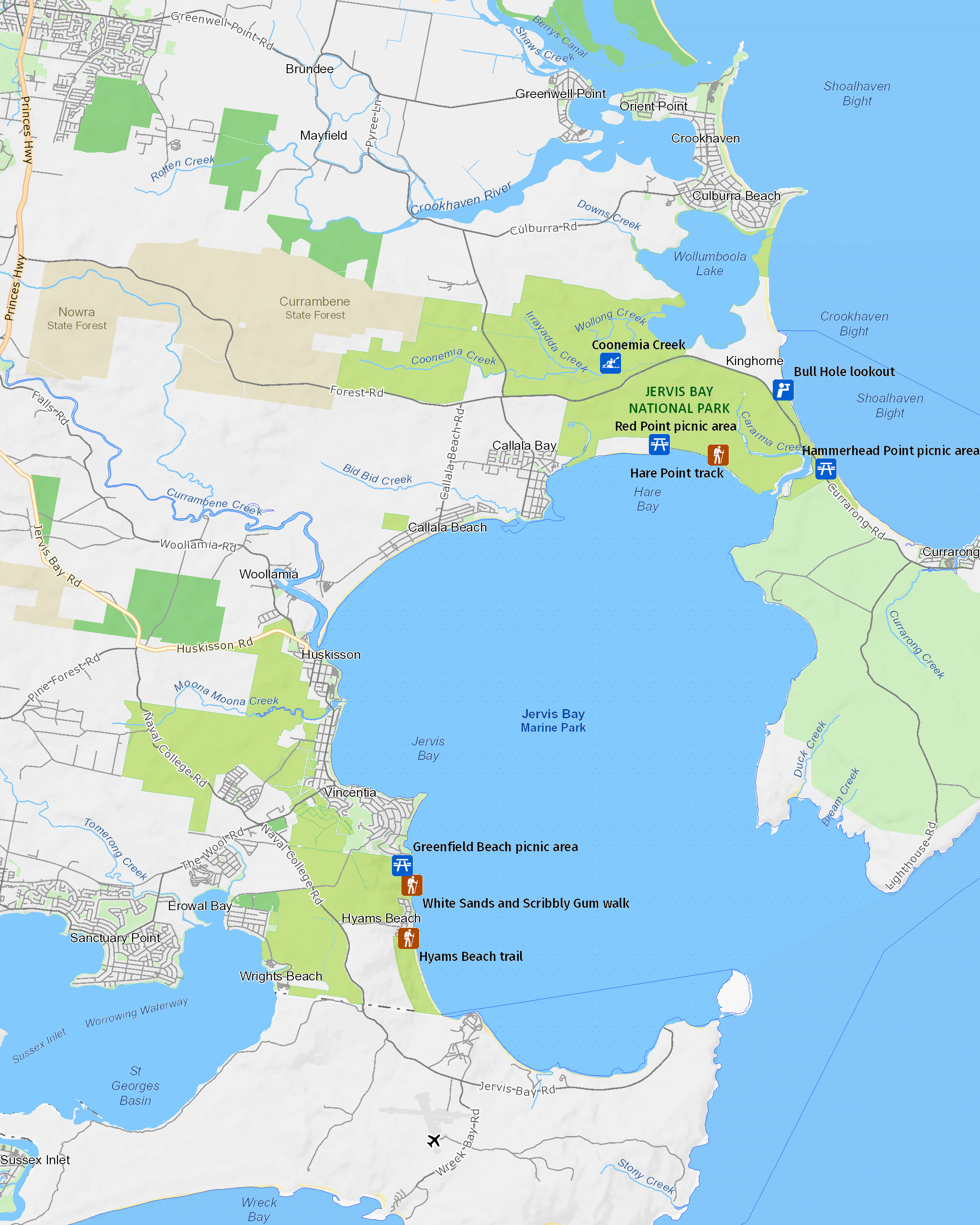
Map legend

Contact
- in the South Coast region
Jervis Bay National Park is always open but may have to close at times due to poor weather or fire danger.
-
-
Nowra office
02 4428 6300
Contact hours: Monday to Friday, 9am to 4pm. - 104 Flatrock Road, Mundamia NSW 2540
-
Email: npws.shoalhaven@environment.nsw.gov.au
-
Nowra office
Visitor info
All the practical information you need to know about Jervis Bay National Park.
Maps and downloads
Nearby towns
Nowra (21 km)
Nowra is a historic city and the commercial heart of the Shoalhaven. It's on the Shoalhaven River close to beaches and national parks.
Ulladulla (56 km)
Ulladulla is close to several wonderful national parks. Morton National Park, to the west, is home to Pigeon House Mountain, a local landmark which is a popular climb. Murramarang National Park, between Ulladulla and Batemans Bay, has beautiful coastal walks, beaches and camping sites.
Kiama (64 km)
A picturesque beachside town on the NSW South Coast, Kiama boasts several local and nearby attractions including the famous Kiama Blowhole, Jamberoo Action Park and Illawarra Fly. Enjoy whale watching during migration season while walking along Kiama Coast Walk, and visit the nearby Minnamurra Rainforest Centre in Budderoo National Park.
Learn more
Jervis Bay National Park is a special place. Here are just some of the reasons why:
Protected birds
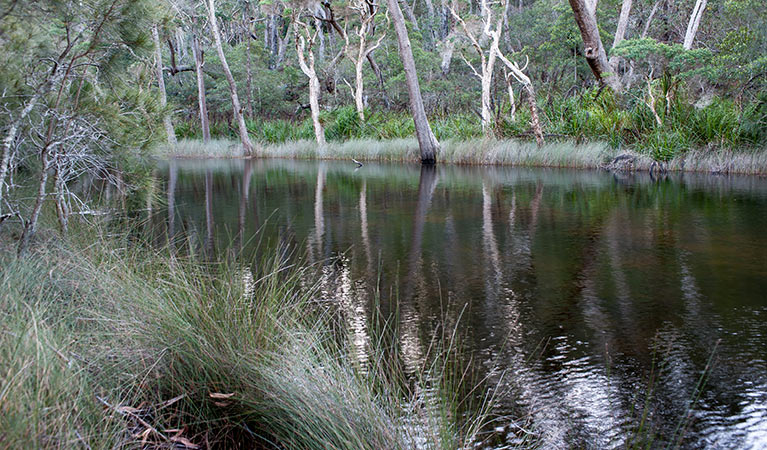
This gorgeous landscape is home to several threatened bird species that dependon the park for survival. The chance of seeing these special birds thriving makes the park a must for everyone, not just birdwatchers. Head to Lake Wollumboola to see waders and water birds or visit the heathland areas, which support eastern bristlebirds and ground parrots. You might see glossy black cockatoos among casuarina forest and powerful owls in woodland.
- Hyams Beach trail Hyams Beach trail, also known as the Bird Spotter’s walk is great for birdwatching in Jervis Bay National Park. Continue the walk to Seamans Beach for a refreshing swim, and loop back along Hyams Beach.
Picture-perfect beaches
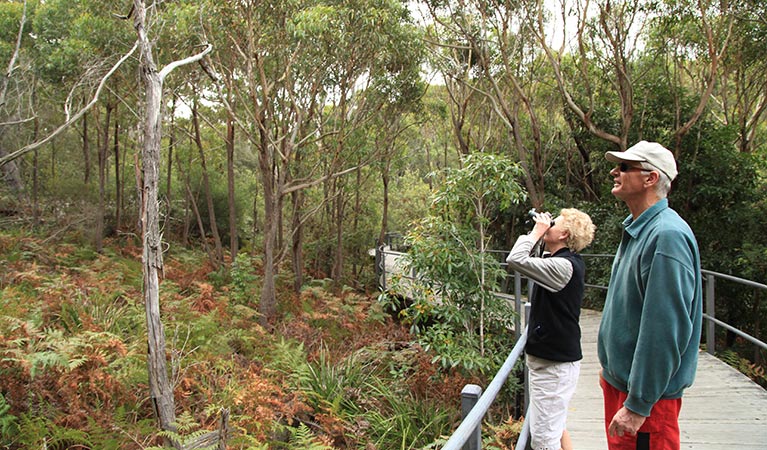
Arriving in this pristine haven, you could be forgiven for thinking you’re in paradise. The region's crystal clear waters and impossibly white sand are among its biggest drawcards – the sea is ideal for fishing, swimming and snorkelling. Be sure to enjoy a wander along Hyams Beach to experience its icing-sugarsand – it’s said to be the world’s whitest.
- Coonemia Creek Coonemia Creek in Jervis Bay National Park is a great spot for fishing, kayaking, birdwatching or a picnic.
- Greenfield Beach picnic area Greenfield Beach picnic area in Jervis Bay National Park is perfect for a barbecue. After a tasty lunch, go for a walk or head down to the beach for a swim or snorkel.
Diverse habitats
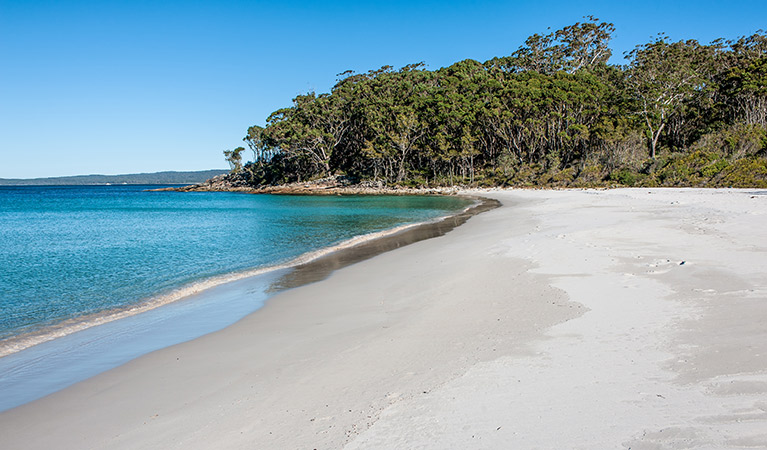
A walk through the park reveals its varied vegetation – from endangered bangalay sand forests to ubiquitous eucalypt woodlands. In the park’s protected gullies you’ll spot rainforest species like lilly pilly and water vine. And if you stop by Carama Inlet or Moona Moona creek, you’ll see saltmarsh and mangroves. Be ready to spot plenty of wildlife among coastal heathland on the sandstone plateau near Vincentia, as well as unique flora in the park’s northern clay-soiled heath.
Ancient connections
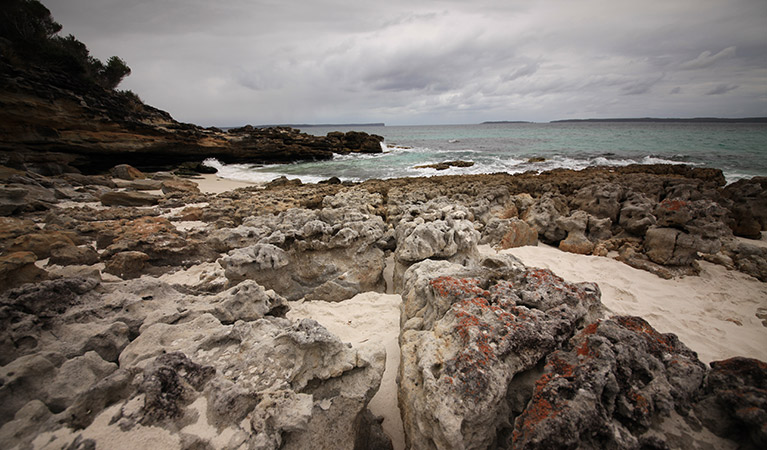
Jervis Bay sits within the lands of the South Coast (Yuin) Aboriginal people of the Dharawal-Dhurga language group. Research shows the area has the highest density and most diverse range of archaeological site types anywhere on the south coast, making this precious park an important place for the preservation of Aboriginal sites, like coastal middens, stone artefacts, rock art, and axegrinding grooves.
- Then and now: Aboriginal culture Aboriginal culture then and now is a Stage 1 (Years 1-2) school excursion in Jervis Bay National Park, focusing on Geography and History. Through story and creative expression, the life and culture of the local people are shared.
- Then and now: Aboriginal culture Then and now: Aboriginal culture is a Stage 3 (Years 5-6) school excursion at Jervis Bay National Park, focusing on HSIE. Through story and creative expression, the life and culture of the local people are shared.
- Then and now: Aboriginal culture Then and now: Aboriginal culture is a Stage 2 (Years 3-4) school excursion in Jervis Bay National Park, focusing on HSIE. Through story and creative expression, the life and culture of the local people are shared.
- Then and now: Aboriginal culture Then and now: Aboriginal culture is an Early Stage 1 (Kindergarten) school excursion in Jervis Bay National Park, focusing on HSIE. Through story and creative expression, the life and culture of the local people are shared.
Plants and animals protected in this park
Animals
-

Yellow-tailed black cockatoo (Calyptorhynchus funereus)
The yellow-tailed black cockatoo is one of the largest species of parrot. With dusty-black plumage, they have a yellow tail and cheek patch. They’re easily spotted while bird watching, as they feed on seeds in native forests and pine plantations.
-

Sugar glider (Petaurus breviceps)
The sugar glider is a tree-dwelling Australian native marsupial, found in tall eucalypt forests and woodlands along eastern NSW. The nocturnal sugar glider feeds on insects and birds, and satisfies its sweet tooth with nectar and pollens.
-

Eastern ground parrot (Pezoporus wallicus wallicus)
The eastern ground parrot is a beautiful, ground-dwelling native bird that lives in low heathland habitat along the NSW North and South coasts and escarpments. It’s listed as a vulnerable species in NSW.
-

White-bellied sea eagle (Haliaeetus leucogaster)
White-bellied sea eagles can be easily identified by their white tail and dark grey wings. These raptors are often spotted cruising the coastal breezes throughout Australia, and make for some scenic bird watching. Powerful Australian birds of prey, they are known to mate for life, and return each year to the same nest to breed.
-

Australian pelican (Pelecanus conspicillatus)
The curious pelican is Australia’s largest flying bird and has the longest bill of any bird in the world. These Australian birds are found throughout Australian waterways and the pelican uses its throat pouch to trawl for fish. Pelicans breed all year round, congregating in large colonies on secluded beaches and islands.
Plants
-

Black sheoak (Allocasuarina littoralis)
The black sheoak is one of a number of casuarina species found across the east coast of Australia and nearby tablelands. Growing to a height of 5-15m, these hardy Australian native plants can survive in poor or sandy soils. The barrel-shaped cone of the black sheoak grows to 10-30mm long.
-

Scribbly gum (Eucalyptus haemastoma)
Easily identifiable Australian native plants, scribbly gum trees are found throughout NSW coastal plains and hills in the Sydney region. The most distinctive features of this eucalypt are the ‘scribbles’ made by moth larva as it tunnels between the layers of bark.
Environments in this park
Education resources (1)
School excursions (4)
- Then and now: Aboriginal culture, Stage 1 (Years 1-2), Geography
- Then and now: Aboriginal culture, Stage 3 (Years 5-6), HSIE
- Then and now: Aboriginal culture, Stage 2 (Years 3-4), HSIE
- Then and now: Aboriginal culture, Early Stage 1 (Kindergarten), HSIE
What we're doing
Jervis Bay National Park has management strategies in place to protect and conserve the values of this park. View the detailed park and fire management documents. Here is just some of the work we’re doing to conserve these values:
Preserving biodiversity
Jervis Bay National Park upholds its biodiversity by protecting vulnerable, threatened and endangered species. Conservation activities are carried out, and include surveying and collecting data on species distribution and population, targeting pest impacts, limiting disturbance from recreational users and undertaking frequent monitoring. NPWS consults on issues potentially affecting biodiversity within the area, and implements programs in relation to this.
Managing weeds, pest animals and other threats
Pests and weeds have a significant impact to the ecosystems within Jervis Bay National Park. Pest reduction of introduced species, such as wild dogs and foxes, as well as risk assessment for new and emerging weeds, is an important part of the work NPWS does to protect the biodiversity values of this national park.
Developing visitor facilities and experiences
NPWS undertakes routine facility maintenance and upgrading in Jervis Bay National Park. Regular maintenance is carried out on park walkways, tracks and other facilities to ensure visitor safety.
Conserving our Aboriginal culture
NPWS works cooperatively with Jerrinja Local Aboriginal Land Council to manage Jervis Bay National Park. Ongoing programs are in place to support this relationship and to preserve the park’s values for future generations.
Managing fire
NSW is one of the most bushfire prone areas in the world as a result of our climate, weather systems, vegetation and the rugged terrain. NPWS is committed to maintaining natural and cultural heritage values and minimising the likelihood and impact of bushfires via a strategic program of fire research, fire planning, hazard reduction, highly trained rapid response firefighting crews and community alerts.

